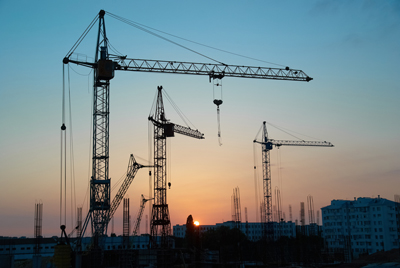Number of metros with job gains hits three-year low; nonresidential starts rise sharply
 Editor’s note: Construction Citizen is proud to partner with AGC America to bring you AGC Chief Economist Ken Simonson's Data DIGest. Check back each week to get Ken's expert analysis of what's happening in our industry.
Editor’s note: Construction Citizen is proud to partner with AGC America to bring you AGC Chief Economist Ken Simonson's Data DIGest. Check back each week to get Ken's expert analysis of what's happening in our industry.
Construction employment, not seasonally adjusted, increased from August 2015 to August 2016 in 220 (61%) of the 358 metro areas (including divisions of larger metros) for which BLS provides construction employment data, decreased in 76 (21%) and was stagnant in 62, according to an AGC release and map on Wednesday. (BLS combines mining and logging with construction in most metros.) The number of metros with increases was the smallest since April 2013 but the number with decreases was similar to other months; this could suggest contractors in some metros are unable to find the workers with requisite skills. The Denver-Aurora-Lakewood metro area again added the most (11,400 combined jobs, 12%), followed by the Anaheim-Santa Ana-Irvine, Calif. division (10,200 construction jobs, 11%) and Orlando-Kissimmee-Sanford (10,200 construction jobs, 17%) and the %). The largest percentage gains again occurred in Boise, Idaho (24%, 4,500 combined jobs) and Orlando-Kissimmee-Sanford. The largest job losses occurred in Houston-The Woodlands-Sugar Land (-3,700 construction jobs, -2%), followed by Birmingham-Hoover, Ala. (-1,500 construction jobs, -6%) and Louisville/Jefferson County, Ky.-Ind. (-1,400 combined jobs, -5%). The largest percentage declines again were in Bloomington, Ill. (-16%, -500 combined jobs), followed by Lawton, Okla. (-11%, -200 combined jobs); Anniston-Oxford-Jacksonville, Ala. (-11%, -100 combined jobs) and Dothan, Ala. (-11%, -300 combined jobs). (Not-seasonally-adjusted data should not be compared to other months.)
Construction data firm ConstructConnect (formerly CMD, Reed Construction Data) reported on September 20 that the value of nonresidential construction starts, not seasonally adjusted, increased 11% from August 2015 and the YTD total was up 12% from January-August 2015. Nonresidential building starts increased 17% YTD, with institutional starts rising 17.5%, commercial starts up 22.5%, industrial starts down 42% and miscellaneous starts up 92%. Heavy engineering (civil) starts climbed 12% YTD, with gains of 1.6% for the largest subsegment (road/highway) and 12% for the next-largest (water/sewage).
"State and local government taxes have continued a slowdown that began in the middle of 2015 and that has extended into the second quarter of 2016," the Rockefeller Institute of Government reported on September 22. "State and local government revenue from major taxes tracked by the Census Bureau grew by 3.0% in the first quarter of 2016, the most recent quarter for which we have full details, which is a substantial slowing from the 5.4% average for the four previous quarters....Total state tax revenue from all sources grew by 1.6% in the first quarter and preliminary data for the second quarter of 2016 indicate declines of 2.1%....The outlook for state budgets in the 2016-17 state fiscal year, which began on July 1st in forty-six states, remains gloomy." Decreases in general revenue can have a dampening effect on all state-funded construction, although some projects are insulated by dedicated revenues, bond funding or federal transfers.
Consultancy IHS Markit and the Procurement Executives Group (PEG) reported on Wednesday that "construction costs contracted at a slower pace in September compared to August....The headline current IHS PEG Engineering and Construction Cost Index registered 48.1 this month, up from 45.4 in August," the 21st consecutive month below the neutral mark, in which a reading higher than 50 represents upward pricing strength; below 50, downward pressure. "This month, the current materials/equipment price index rose to the neutral mark. Since April, this sub-index has been oscillating between 47 and 50, a reflection of the volatility in commodity markets. In September, out of 12 categories, five showed falling prices, four had rising prices, and in three categories, prices remained unchanged. Only two categories had softer prices compared to August: copper-based wire and cable and turbines....The current subcontractor labor recorded its fifth consecutive month below the neutral mark as it fell once again in September. Labor costs were not as soft as in August, with the index rising from 40.5 to 43.7 this month.
"September turned out to be a big month for big data center construction project announcements in the US," the online newsletter Data Center Knowledgereported on September 22. "New Mexico has secured a commitment from Facebook to build its next data center in the Village of Los Lunas. The first phase of construction, expected to start later this year, will produce a 510,000-square foot facility and cost about $250 million, according to a joint statement by Facebook and the office of New Mexico Governor Susana Martinez. Facebook is likely to continue expanding in this location in the future as it does in its other data center locations....SAP America, US subsidiary of the German enterprise software giant SAP SE, has selected Colorado Springs as the location of two massive-scale future data centers.... Data Foundry is preparing to break ground on the third data center in Austin, which is where the company is based. The future facility, called Texas 2, will go up on the company's data center campus called Data Ranch, home to its Texas 1 data center....It expects to have invested about $200 million by the time all three planned construction phases are complete....Phase One, due to start this this quarter, will "tentatively" launch in the third quarter of 2017, Data Foundry said in a statement. [TierPoint] announced a plan for its 40th facility—a 90,000-square-foot data center in Allen, Texas. The site's first phase will provide 16,000 square feet of raised floor and cost about $20 million, the company said."
The Data DIGest is a weekly summary of economic news; items most relevant to construction are in italics. All rights reserved. Sign up at www.agc.org/datadigest.


